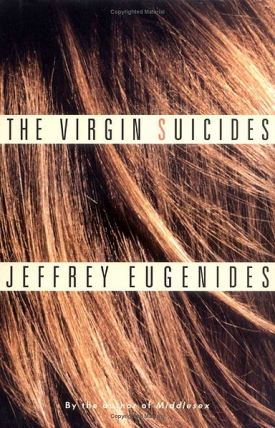Something I briefly mentioned in an earlier post, but didn't get around to explaining is the very noticeable colour change that occurs throughout the movie. Sofia Coppola is really skilled at using colour tones to create a mood or atmosphere, as I have seen this technique in all of her movies. The Virgin Suicides is no exception. There are certain scenes that highlight a climax in the plot, and from these scenes comes a tone change or adjustment, because a new feeling in society and throughout the neighbourhood is introduced. This is one of the reasons this movie is so effective.

This is a frame from the beginning of the movie. Therese sits in the corner of the frame looking up into the sunset. The sunset may indicate a new dawn or part of the girl's life. To me, it always looked like the girls were spending time in the last part of their childhood, symbolized as the setting sun. Therese looks carefree and wistful at the same time. The grass around them symbolizes the beauty in the simplicity of nature. Notice that it is not an elaborate garden or remarkable forest; it is simply a patch of grass and weeds. This shows how the girls found beauty in nature, in the beauty that is all around in the world that most people seem to miss. Lux's face appears in the rest of the frame. It is just an outline of her face, faded like a memory. This adds to the dreamy quality of the sequence, but also may indicate that the boys' memory of Lux is faded. The fact that the girls' faces from two different shots in spliced indicates that the girls have some sort of mental and emotional connection, almost like they have a collective set of feelings and thoughts. I like this shot because it shows a side of Therese that is otherwise not touched on in the book.

This shot is taken during the party when Cecilia has jumped out of her bedroom window and is impaled on the fence outside. This shot interests me because it gives a view of the action from the street, as an outside observer would see it. One can see that it is very obvious that the Lisbon family likes their privacy, because there are heavy curtains in some windows, and gauzy curtains in the rest of the windows. This gives an air of mystery. Cecilia herself is in the darkness, and her and her father's face are unseeable. Mrs. Lisbon appears in the light, playing the role of protective parent, her arms are out so the girls can't see what has happened to their sister. This is one of the only moments that I liked Mrs. Lisbon as a mother and one of the only times I saw how hard she works to protect her children. The tone here is very dark and sinister, but also very peaceful at the same time. The faint glow on Cecilia makes her look like an angel or other otherworldly creature.

The tone of this shot seems unassuming at first, but it kind of reminds me of the first shot, except the colour looks fake and forced, as if the happiness is not real. The boys are scattered throughout the photo; if the viewer was not looking for them, they might not have been seen because they blend in. Most of the other students in the picture are brunette, and the Lisbon blonde stands out, making them the focus. Interestingly enough, this is not a very good picture of any of the Lisbon girls. Lux looks angry and sullen, Bonnie has her arms crossed and Mary and Therese look as if they are forcing smiles. From right to left, the picture reads from the eldest sister to the youngest sister, but reasons for this I cannot fathom. It may be the order of death as well. This image starts out far away, and we see many other students, but we cut to a closer snapshot of the girls with every take, as if the viewer of the photo is trying to analysis them, to look for some foreshadowing, something pointing to what's to come. The fact that the photo starts off so far away indicates that the girls may have gotten lost in a sea of people at school, and went unnoticed by everyone except the boys.

This scene is not to be annotated, but I have read something very compelling about this particular shot. This is the snapshot that Mr. Lisbon takes of the girls before they go to the prom. Note that Lux's hand looks like she is holding a cigarette, which is how she is found when she dies. Therese's eyes are closed, and she ends up overdosing on sleeping pills. Mary coughs right after the photo is taken, and she dies by putting her head in the oven. Bonnie's arm looks like a noose around hr neck, like how she commits suicide. This part of the movie wasn't included in the book because it would not be so subtle in text as it is on film. Just something interesting I found out about!







